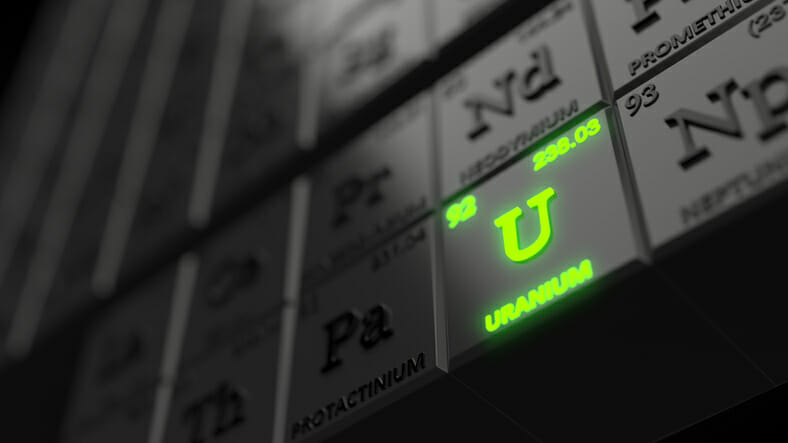Growing global interest in nuclear power as a carbon-free source of energy has led to increasing prices for uranium used as nuclear power plant fuel as well as the shares of companies that mine and process uranium. There is no commodities market for the radioactive mineral so investors who want to profit from uranium’s rise have to invest in stocks and exchange-traded funds. Here’s what you need to know.
A financial advisor could help you put a financial plan together for your investing needs and goals.
Basics of Uranium Investing
Uranium is primarily used as fuel to power the nuclear fission plants that produce about 10% of the world’s electricity. It represents an emissions-free alternative to fossil fuels while also being more reliable than renewable energy sources such as wind and solar.
Uranium is a non-renewable resource that is mined in many countries. Kazakhstan, Canada and Australia are the major producers of uranium, while the United States is the biggest user of it. Prices for uranium fell sharply after the 2011 accident at Japan’s Fukushima nuclear power facility. However, demand for uranium is reviving today and is expected to continue, in part, as nations try to meet requirements of international agreements to reduce global warming.
How to Invest in Uranium Companies

Although uranium is a commodity, because it is radioactive it isn’t traded like less dangerous commodities such as gold and oil. The most popular way to invest in uranium is through buying shares of companies involved in the production and processing of uranium. Stocks of uranium companies can be purchased through an online or traditional brokerage account. Here are six leading companies in the uranium business:
- Cameco Corp. (CCJ) is one of the biggest producers of uranium. The Canadian company is active in exploration, mining and fuel manufacturing and has reserves of more than 485 million pounds of uranium. Its shares are traded on the New York Stock Exchange and the Toronto Stock Exchange.
- Kazatomprom (KAP) is the Kazakhstan national uranium company and the largest global producer of uranium. It explores for and mines uranium deposits and manufactures power plant fuel. Its shares trade on the Astana International Exchange in Kazakhstan as well as the London Stock Exchange.
- BHP Group Limited (BHP) is the world’s biggest mining company and a major producer of uranium. It is based in Australia and its shares trade on the Australian Stock Exchange, London Stock Exchange and Johannesburg Stock Exchange. The New York Stock Exchange lists BHP’s American Depositary Receipts.
- Rio Tinto (RIO) is a large, diversified mining company that extracts a relatively small amount of uranium along with other minerals from its mines around the world. Shares of the London-based company trade on the London Stock Exchange and the Australian Stock Exchange. Its American Depositary Receipts are listed on the New York Stock Exchange.
- Uranium Energy Corp (UEC), based in Corpus Christi, Texas, operates uranium mines ins several American states as well as other countries. It has also built a sizable stockpile of uranium purchased from others in expectation of continued price increases for the commodity. Uranium Energy trades on the New York Stock Exchange.
- Yellow Cake PLC (YCA) is a trading company that buys an unrefined form of uranium ore known as yellowcake, primarily from Kazatomprom, and sells it to companies that process it into fuel. Shares in the United Kingdom-based company trade on the London Stock Exchange.
Investing With Uranium ETFs
Exchange-traded funds that invest in baskets of uranium-related companies provide investors with a convenient way to acquire diversified portfolios of holdings in the sector. Uranium ETFs typically track an index of uranium shares. Here are three leading ETFs:
- Global X Uranium ETF (URA) invests in uranium mining companies as well as businesses that produce equipment for the uranium and nuclear industries. It is managed to track the Solactive Global Uranium & Nuclear Components Total Return Index. Shares trade on the New York Stock Exchange.
- Sprott Uranium Miners ETF (URNM) invests primarily in shares of companies that are part of the North Shore Global Uranium Mining Index. These companies may mine uranium, stockpile uranium or invest in uranium royalties. Shares trade on the New York Stock Exchange.
- VanEck Vectors Uranium+Nuclear Energy ETF (NLR) tries to track the MVIS Global Uranium & Nuclear Energy Index of uranium miners as well as companies that build, service or produce power from nuclear plants. Its shares trade on the New York Stock Exchange.
Assessing Risks and Challenges for Uranium Investments
If you want to invest in uranium, market volatility is a key factor to consider. Prices can swing dramatically due to shifts in nuclear energy demand and geopolitical issues in uranium-rich regions. These fluctuations could therefore impact the profitability of uranium stocks and require you to keep a close eye on developments.
Regulatory changes could also pose a risk to uranium investments. The nuclear industry faces strict regulations, and any changes in policy can directly affect uranium demand. For example, a country reducing its reliance on nuclear energy can significantly decrease demand for uranium, negatively impacting investments.
Public opinion and reactions to nuclear incidents also influence uranium investments. Events like the 2011 Fukushima disaster can lead to public resistance to nuclear power, prompting policy changes that may reduce uranium demand. Such events can quickly affect investor sentiment and lead to sharp investment declines.
Lastly, sustainability and ethical practices in uranium mining are very important. Investors should consider how uranium is extracted and processed, focusing on companies that adhere to high environmental and ethical standards. Investing in companies that neglect these practices can lead to regulatory issues and damage to investor reputation, whereas ethical investments could help to ensure compliance with global standards and support long-term sustainability.
Bottom Line

Investing in uranium allows investors to participate and potentially profit from a perceived global shift toward nuclear power driven in part by concerns about global warming. Uranium can’t be traded like other commodities, but investors can purchase shares in a number of public companies involved in mining, processing and trading the mineral. Exchange-traded funds that invest in baskets of uranium- and nuclear-related companies provide a convenient way to acquire a diversified uranium portfolio.
Investing Tips for Beginners
- A financial advisor can help you fit an investment in uranium into your long-term investment goals. SmartAsset’s free tool matches you with vetted financial advisors who serve your area, and you can have a free introductory call with your advisor matches to decide which one you feel is right for you. If you’re ready to find an advisor who can help you achieve your financial goals, get started now.
- The right mix for your investment portfolio depends on your time horizon and risk tolerance. To see what it is for you, use our asset allocation calculator. It gives you a glimpse of what different investment portfolios may look like based on your risk tolerance.
Photo credit: ©iStock.com/gorodenkoff ©iStock.com/Artjom Kissler, ©iStock.com/kasezo
